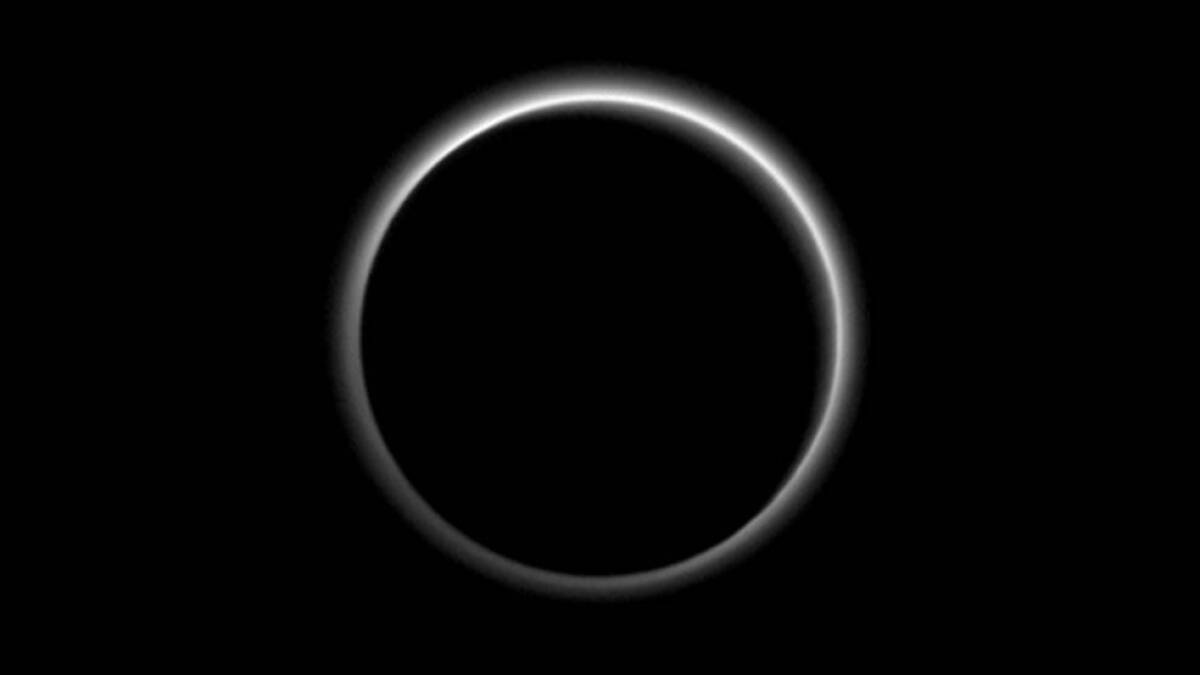Holy halo! New Horizons gets a good look at Plutoâs dark side

Get ready to see Pluto like youâve never seen it before. Scientists with NASAâs New Horizons mission have released fresh images taken by the spacecraft, and these unprecedented views of the dwarf planetâs surface are nothing short of spectacular.
Even though the mission scientists have downloaded only 4% to 5% of the available data since the spacecraftâs historic July 14 flyby, the new images are revealing what a complex world Pluto is turning out to be, with flowing ice, a high atmosphere and nitrogen snow.
In one image taken of the dark side of the icy world, the backlit dwarf planet looks stunning, its silhouette surrounded by the bright halo of its atmosphere.
âThis was the image that almost brought tears to the eyes of the atmospheric sciences team,â Michael Summers, a mission co-investigator at George Mason University in Fairfax, Va., said in a press briefing.
But the image isnât simply pretty to look at â itâs also shedding fresh light on the nature of the dwarf planetâs atmosphere, which extends much farther than scientists expected. A hazy layer seems to stretch at least 100 miles in altitude â roughly five times what the models predicted, Summers added.
The findings, he said, âare basically changing the way we think about Plutoâs atmosphere. Weâll have to start from scratch.â
The bright heart covering much of Plutoâs surface might be nitrogen snow that was painted onto the surface from a source somewhere in the heartâs left lobe, said Alan Stern, New Horizonsâ principal investigator at the Southwest Research Institute in Boulder, Colo.
âWe think that weâre coming to understand this feature just a little bit,â he said. âIt is early days; we may have a little bit more to say about that.â
The edges around a region in the heartâs left lobe called Sputnik Planum also show signs of being carved up by ice rather like glaciers do on Earth â except that water ice on Pluto would be so frozen that it would not be able to flow the way it does on Earth.
Instead, the ices on Pluto are likely made of frozen carbon monoxide, nitrogen or methane, which can still flow a little bit even at the distant dwarf planetâs frigid surface temperatures, said William McKinnon, a mission co-investigator at Washington University in St. Louis. And indeed, scientists have spotted what they think are nitrogen ice flows in the area.
âWe have actual evidence for, basically, recent geological activity,â he said.
Pluto, little world though it may be, has served up more than its fair share of surprises, and Stern appeared to raise the possibility that Plutoâs planetary status had the potential to be reconsidered.
âItâs very hard not to call an object like this â with this level of complexity, an atmosphere, with potentially an internal ocean, certainly with complicated seasonal cycles, and certainly a big complicated system of moons â a planet,â Stern said.
âWeâre going through a period of transition,â he added, âand those definitions are in transition as well.â
Packing your bags for Pluto? Follow @aminawrite for more interplanetary science news.







